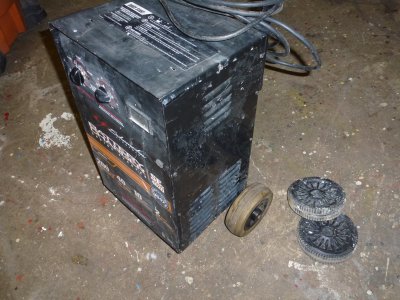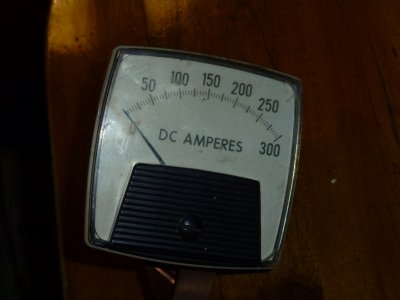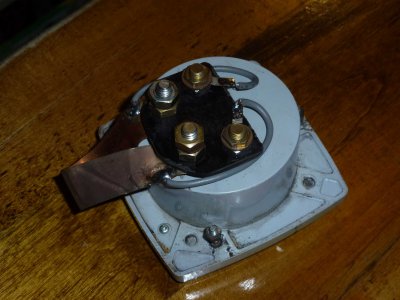- Joined
- Feb 7, 2013
- Messages
- 2,486
Another scrapyard treasure that needed some help followed me home a while ago. There isn't anything wrong with it except that the ammeter is gone and a few loose wires, the fan needed oil, and the wheels were all but shot. I removed the old plastic wheels in favor of a pair of ball bearing
wheelchair wheels that I had left over from a previous project. The circuit for this Schumacher 4020SE charger is somewhat interesting in that
the ammeter seems to be connected to the primary side of the transformer somehow. Apparently it used an AC ammeter although I am not positive
on that point. At any rate, if I can come up with an appropriate meter and wire it up, it should perform as intended. Meanwhile the unit has
varying voltage outputs for the different charging rates so basically it is working.

It turned out that the wheel chair wheels were a perfect fit to replace the plastic excuses for wheels that were on there. The new wheels have ball bearings and work really smoothly around the shop now.
Schumacher seems to have a lot of circuit diagrams on the web for this basic style of manual machine. Basically it has a transformer with a
tapped primary giving varying voltage outputs to the secondary of the transformer. It uses a full wave rectifier circuit using two diodes.
Interestingly, the large box is at least half empty with the transformer and fan in the bottom of the box, impressive until you look inside.
I have another Schumacher with the same 200 AMP boost in a small box with a carrying handle, probably the same basic circuit. Maybe I
will rip into that and see how that one is configured. To it's credit it is an analog charger that will last forever if taken care of in comparison
to the SMPS(switch more power supply) chargers that are currently on store shelves.
I still need to do a little more cleaning on this unit as the pigeons didn't have much respect for it.
wheelchair wheels that I had left over from a previous project. The circuit for this Schumacher 4020SE charger is somewhat interesting in that
the ammeter seems to be connected to the primary side of the transformer somehow. Apparently it used an AC ammeter although I am not positive
on that point. At any rate, if I can come up with an appropriate meter and wire it up, it should perform as intended. Meanwhile the unit has
varying voltage outputs for the different charging rates so basically it is working.

It turned out that the wheel chair wheels were a perfect fit to replace the plastic excuses for wheels that were on there. The new wheels have ball bearings and work really smoothly around the shop now.
Schumacher seems to have a lot of circuit diagrams on the web for this basic style of manual machine. Basically it has a transformer with a
tapped primary giving varying voltage outputs to the secondary of the transformer. It uses a full wave rectifier circuit using two diodes.
Interestingly, the large box is at least half empty with the transformer and fan in the bottom of the box, impressive until you look inside.
I have another Schumacher with the same 200 AMP boost in a small box with a carrying handle, probably the same basic circuit. Maybe I
will rip into that and see how that one is configured. To it's credit it is an analog charger that will last forever if taken care of in comparison
to the SMPS(switch more power supply) chargers that are currently on store shelves.
I still need to do a little more cleaning on this unit as the pigeons didn't have much respect for it.




